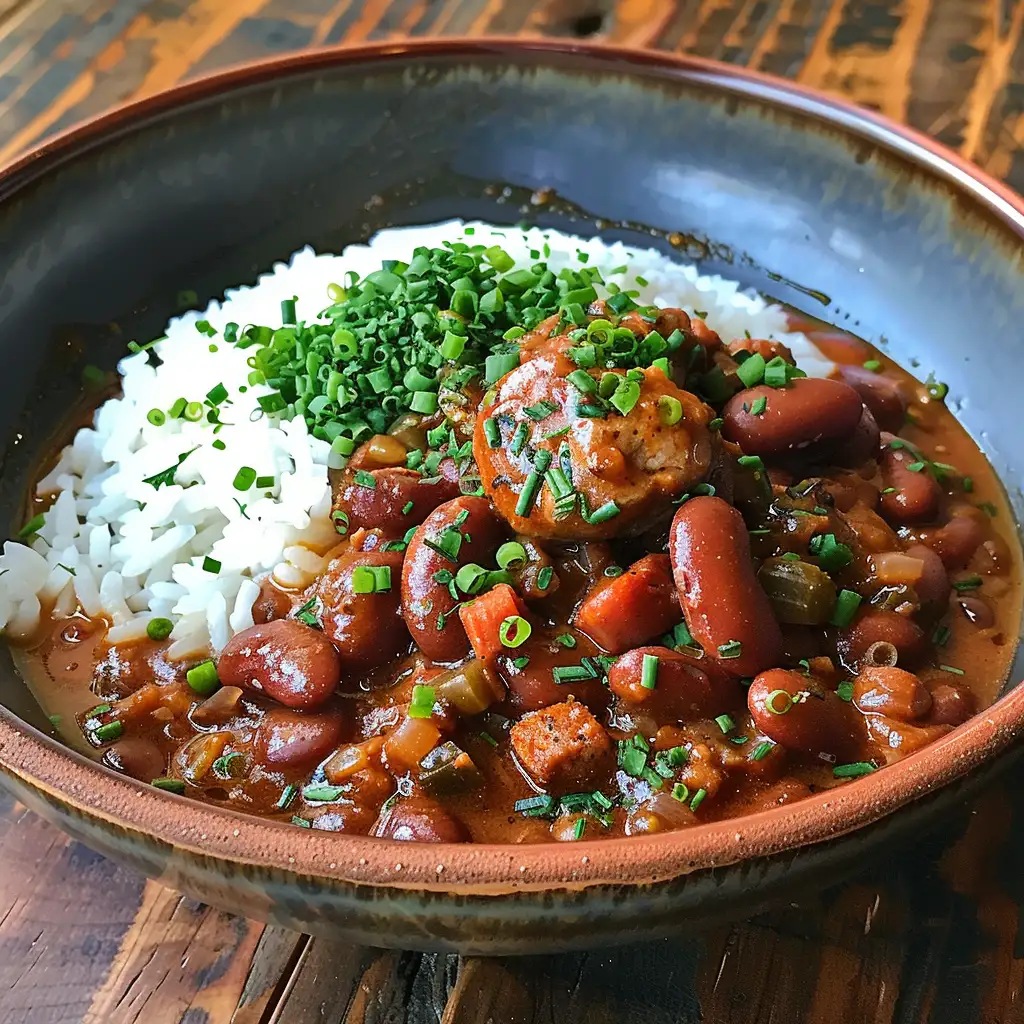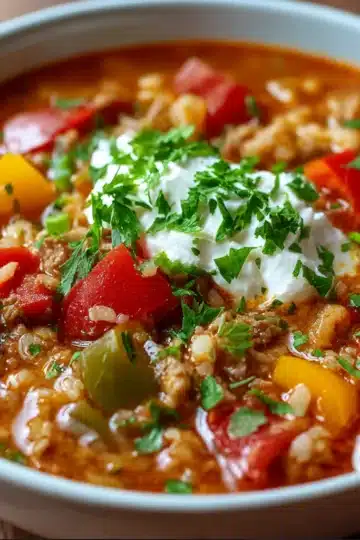Introduction
New Orleans-style red beans and rice is not just a dish; it's a deep-rooted tradition that resonates through the heart of New Orleans culture. This simple yet hearty meal has been a staple among locals for decades, traditionally served on Mondays. The recipe’s simplicity, requiring little hands-on attention while delivering rich and robust flavors, makes it a testament to the ingenious cooking traditions of the region.
- Brief history: The tradition of red beans and rice began when homemakers would use leftover pork bones from Sunday dinner to cook with red beans, and the dish would simmer throughout the day while the week’s laundry was being done.
- Importance in culture: In New Orleans, this dish goes beyond mere sustenance; it carries historical significance and embodies the spirit of resourcefulness and community. It’s a communal dish, meant to be shared with warmth and laughter, reinforcing family ties and friendships.
- Cooking method and ingredients: The method is straightforward—slow-cooked red beans, smoked sausage, and the "Holy Trinity" of New Orleans cooking: onions, celery, and bell peppers. Spices and herbs add depth, while rice serves as the perfect canvas for the flavorful beans.
Origins and Cultural Significance
The origins of red beans and rice are as humble as the ingredients themselves. Traditionally prepared on Mondays, this dish utilized leftovers in a way that maximized flavor while minimizing waste, reflecting the resourcefulness of the New Orleans people.
- Monday staple:
- Historically, Monday was wash day, and families needed a meal that could cook itself while they attended to the labor-intensive task of laundry.
- Red beans were chosen for their ability to be left simmering on the stove for hours, their creamy texture developing over time, enhancing the overall flavor of the dish.
- Culinary identity:
- Red beans and rice quickly became a culinary symbol of New Orleans, embodying the fusion of cultures and flavors that make up the city’s unique gastronomy.
- The dish is a perfect example of Creole cooking, which blends West African, French, Spanish, and Native American influences.
- Laundry day tradition:
- The significance of serving this dish on Mondays is a direct nod to the past, when the rhythm of household chores dictated meal preparation.
- This tradition has been preserved and embraced in modern times, with many restaurants and homes continuing to serve red beans and rice at the start of the week.
Explore the rich history of New Orleans cuisine with this Smithsonian Magazine article, which delves deeper into how these global influences beautifully collide in dishes like red beans and rice.
This dish, steeped in history and community, is a true reflection of New Orleans’ vibrant culture and enduring traditions. It’s more than food; it’s a weekly celebration of New Orleans life, its roots going back to the very essence of everyday survival and culinary ingenuity.
Variations and Substitutions
While the traditional New Orleans-style red beans and rice recipe is beloved, there are numerous ways to tailor it to different tastes and dietary needs. Whether you're seeking a vegetarian option or just want to mix up the ingredients, these variations ensure that this dish can be enjoyed by everyone.
- Alternative Beans and Meats:
- Beans: Aside from the classic red kidney beans, other varieties such as pinto beans, navy beans, or black beans can be used to great effect.
- Meats: While andouille sausage and ham hocks are traditional, you can use smoked turkey, chorizo, or even shrimp to add different flavors and textures to the dish.
- Vegan and Vegetarian Versions:
- Omit the meat and use vegetable stock instead of chicken stock. Liquid smoke can add a hint of smokiness that sausage typically provides.
- Use vegan sausages or a hearty substitute like mushrooms or jackfruit to mimic the texture and flavor of traditional meats.
- Adjustments for Spice Levels and Dietary Restrictions:
- Spice levels can be easily adjusted by increasing or reducing the amount of cayenne pepper or adding chopped jalapeños for extra heat.
- For a gluten-free version, ensure that all packaged ingredients such as sausage are certified gluten-free.
- Low-sodium diets can be accommodated by reducing the salt added and choosing low-sodium stocks and sausages.
For those looking to dive deeper into the art of bean cooking, which is central to perfecting red beans and rice, explore further with Epicurious’ comprehensive bean guide.
Serving and Presentation
Proper serving and presentation can elevate red beans and rice from a humble dish to a heartwarming meal that impresses guests.
- How to Serve:
- Serve hot directly from the stove. Place the rice in a bowl or a plate and ladle the beans over the top, allowing the sauce to permeate the rice.
- For communal settings, keep the red beans and rice in a large pot and let guests serve themselves family-style.
- Accompaniments and Garnishes:
- Traditional sides include cornbread, a crisp green salad, or steamed green vegetables such as broccoli or collard greens.
- Garnish with chopped green onions, parsley, or a sprinkle of Creole seasoning to add color and flavor.
- Presentation Tips:
- Use a white dish to make the colors of the red beans and rice pop.
- Consider adding a final drizzle of olive oil or a few drops of hot sauce on top to enhance the visual appeal and taste.
For an in-depth look at traditional Southern cooking, which often includes dishes like red beans and rice, visit The Spruce Eats.
FAQs
Why soak beans overnight?
- Soaking beans overnight helps to reduce cooking time and improve texture. It also aids in digestibility and can help to reduce the effects of gas for some people.
Can canned beans be used instead?
- Yes, canned beans are a convenient alternative to dried beans. Be sure to rinse them thoroughly to remove excess sodium and adjust the cooking time since they are already cooked.
Best type of sausage for authentic flavor?
- Andouille sausage is the best choice for authentic New Orleans flavor. It’s spicy and smoky, which enhances the other seasonings used in the recipe.
How to adjust the spice level?
- Adjust the spice level by varying the amount of cayenne pepper. Start with a small amount and add more as needed. For those sensitive to heat, adding the pepper incrementally allows for better control over the dish’s spiciness.
Mastering the perfect red beans and rice involves understanding the components and nuances that can be adjusted to suit any preference or dietary need, ensuring this dish remains a versatile and beloved classic. For more tips on adjusting traditional recipes, check out Epicurious’ guide to cooking beans, which offers great insights into making substitutions that don't compromise on flavor or texture.
Conclusion
Throughout this exploration of New Orleans-style red beans and rice, we've covered everything from the origins and cultural significance of this iconic dish to the detailed steps involved in making it at home. Whether you stick to the traditional recipe or incorporate some of the variations and substitutions suggested, this dish is sure to provide comfort and satisfaction.
- Recap of Key Points:
- The importance of red beans and rice in New Orleans culture, particularly as a Monday staple.
- Various adaptations including vegan/vegetarian versions and adjustments for different dietary needs.
- Tips for perfect presentation and serving to enhance your dining experience.
We encourage you to try making this beloved dish at home—it's a flavorful way to bring a piece of New Orleans into your kitchen!
Embark on a culinary journey through the South with these insightful resources and discover how traditional dishes can be adapted to suit any taste or occasion. The adventure is just a recipe away!
Print
New Orleans-Style Red Beans and Rice
- Total Time: 2 hours 40 minutes (plus overnight soaking)
- Yield: Serves 8
- Diet: Gluten Free
Description
This New Orleans-Style Red Beans and Rice recipe brings the heart and soul of Louisiana to your table. It features creamy red beans cooked with spices, Andouille sausage, and a ham hock, served over steaming white rice. This dish is not only a staple in Southern cuisine but also a rich, comforting meal perfect for gatherings or a hearty weeknight dinner.
Ingredients
- 1 lb dried red kidney beans
- 1 lb smoked sausage, sliced
- 1 onion, chopped
- 1 green bell pepper, chopped
- 2 stalks celery, chopped
- 3 cloves garlic, minced
- 2 bay leaves
- 1 teaspoon dried thyme
- 1 teaspoon dried oregano
- ½ teaspoon cayenne pepper
- Salt and black pepper to taste
- Cooked white rice, for serving
- Chopped green onions, for garnish
Instructions
- Rinse the red kidney beans under cold water and pick out any stones or debris. Place the beans in a large bowl and cover with water. Let soak overnight, then drain and rinse.
- In a large pot or Dutch oven, heat a bit of oil over medium-high heat. Add the sliced smoked sausage and cook until browned, about 5 minutes.
- Add the chopped onion, green bell pepper, and celery to the pot. Cook, stirring occasionally, until the vegetables are softened, about 5-7 minutes.
- Stir in the minced garlic, bay leaves, dried thyme, dried oregano, and cayenne pepper. Cook for another 1-2 minutes, until fragrant.
- Add the soaked and drained red kidney beans to the pot. Pour in enough water to cover the beans by about 2 inches.
- Bring the mixture to a boil, then reduce the heat to low. Cover and simmer, stirring occasionally, until the beans are tender and creamy, about 1 ½ to 2 hours.
- Once the beans are cooked, use a potato masher to mash some of the beans against the side of the pot to thicken the mixture.
- Season the red beans and sausage mixture with salt and black pepper to taste.
- Serve the red beans and sausage over cooked white rice, garnished with chopped green onions.
Prep Time: 15 minutes (plus overnight soaking) Cook Time: 2 hours Servings: Makes about 6-8 servings
Notes
- Soaking the beans overnight helps reduce cooking time and improve their texture.
- Adjust the amount of cayenne pepper according to your heat preference.
- Can be stored in the refrigerator for up to 5 days or frozen for 3 months.
- Prep Time: 10 minutes
- Cook Time: 2 hours 30 minutes
- Category: Main Dish
- Method: Stewing
- Cuisine: American (Southern/Cajun)
Nutrition
- Calories: 500
- Sodium: 750mg
- Fat: 22g
- Carbohydrates: 50g
- Fiber: 10g
- Protein: 25g







